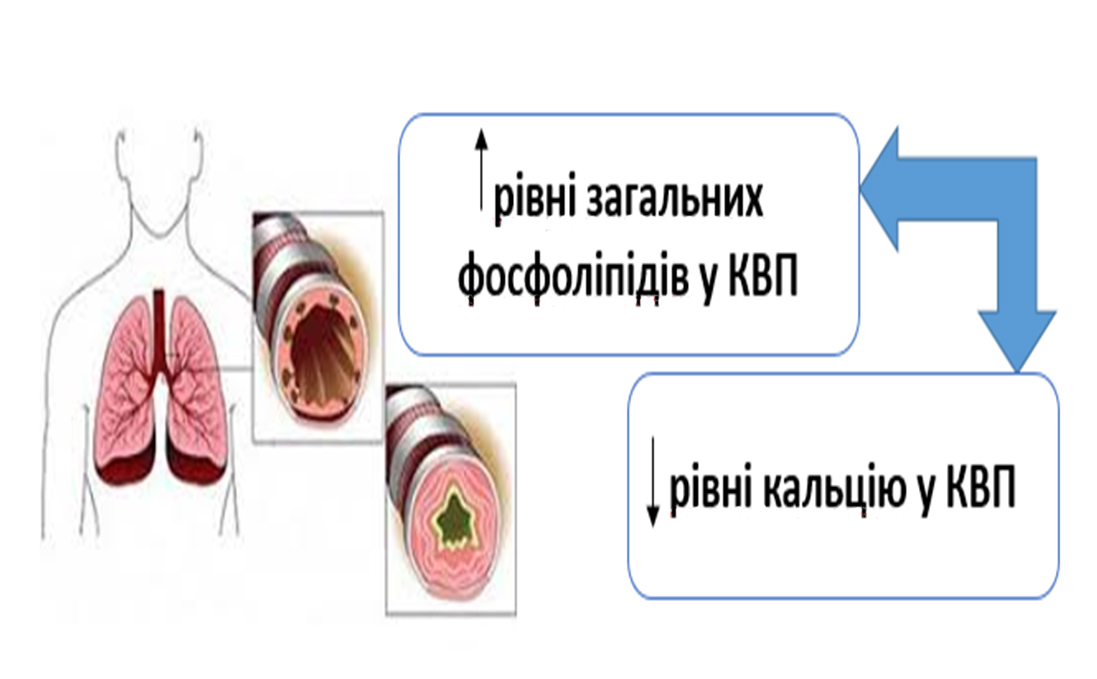Analysis of exhaled breath condensate in patients with asthma and recurrent wheezing
DOI:
https://doi.org/10.15587/2519-4798.2024.298556Keywords:
recurrent wheezing, asthma, exhaled breath condensate, phospholipids, childrenAbstract
Wheezing is the most common clinical symptom of bronchial obstructive syndrome. The functions of pulmonary surfactant (PS) depend directly on the level of total phospholipids (TP). This can be used to assess the integrity of the cell membrane structure.
Objective. To determine the level of total phospholipids and calcium in exhaled breath condensate in young children with recurrent wheezing and asthma.
Materials and methods. The study included 77 patients divided into 3 groups. Group 1 included 30 patients (20 girls and 10 boys) with no more than 2 episodes of recurrent wheezing in their lifetime; Group 2 -10 patients (6 boys and 4 girls) with more than 3 episodes of recurrent wheezing, and 37 patients (15 girls, 22 boys) with asthma. The control group consisted of 20 conditionally healthy children (11 girls, 9 boys). All patients were aged from 3 months to 6 years. The determination of phospholipid levels and calcium (Ca) in the exhaled breath condensate was performed in dynamics - during the period of clinical manifestations and remission.
Results. The level of phospholipids in the exhaled breath condensate was the highest in patients of all groups at the stage of clinical manifestations compared with the period of remission, while its lowest level was noted in the control group. During the peak of the disease, the level of Ca in the exhaled breath condensate was significantly lower compared to the period of remission. The control group had the highest level.
Conclusions. The exhaled breath condensate's high level of phospholipids in the first days of the disease confirms cell damage in the presence of inflammation. Additionally, the exhaled breath condensate's Ca level is lowest during this period, possibly indicating its involvement in cell damage
References
- Makieieva, N. I., Afanasieva, O. O., Aleksieieva, N. P., Yarova, K. K., Malakhova, V. M, Odynets, P. I. (2020). Bronkhoobstruktyvnyi syndrom ta formuvannia khronichnoi bronkholehenevoi patolohii u ditei: faktory ryzyku. Problemni pytannia diahnostyky ta likuvannia ditei iz somatychnoiu patolohiieiu. Kharkiv, 100–102.
- Ma, H., Li, Y., Tang, L., Peng, X., Jiang, L., Wan, J. (2018). Impact of childhood wheezing on lung function in adulthood: A meta-analysis. PLOS ONE, 13 (2), e0192390. https://doi.org/10.1371/journal.pone.0192390
- Antypkin, Yu. H., Chumachenko, N. H., Umanets, T. R., Lapshyn, V. F. (2016). Analysis of morbidity and prevalence of bronchial asthma among children from different age groups and regions in Ukraine. Perynatolohiia ta pediatriia, 1 (65), 95–99.
- Hall, S. C., Fischer, K. D., Agrawal, D. K. (2015). The impact of vitamin D on asthmatic human airway smooth muscle. Expert Review of Respiratory Medicine, 10 (2), 127–135. https://doi.org/10.1586/17476348.2016.1128326
- Ogeyingbo, O. D., Ahmed, R., Gyawali, M., Venkatesan, N., Bhandari, R., Botleroo, R. A. et al. (2021). The Relationship Between Vitamin D and Asthma Exacerbation. Cureus, 13 (8). https://doi.org/10.7759/cureus.17279
- Abaturov, A., Kryuchko, T., Kryvusha, E., Tkachenko, O. (2021). Nutritional and pharmacological correction of calcium and vitamin D deficiency in children. Child`S Health, 13 (7), 681–690. https://doi.org/10.22141/2224-0551.13.7.2018.148922
- Lytvynets, L., Lytvynets-Holutiak, U., Lytvynets, V. (2021). Otsinka mineralnoho dysbalansu u ditei z bronkhialnoiu astmoiu. National health as determinant of sustainable development of society, 175.
- Smiian, O. I., Kurhanska, V. O., Moshchun, O. P. (2011). Kontsentratsiia tsynku,midi, mahniiu ta kaltsiiu v syrovattsi krovi ditei, khvorykh na bronkhialnu astmu, ta yii zalezhnist vid stupenia tiazhkosti zakhvoriuvannia. Pediatriia, akusherstvo ta hinekolohiia, 5, 7–10.
- Odynets, Yu. V., Ruchko, A. F., Cherednikova, T. Yu. (2013). Mozhlyvosti monitorynhu hostrykh bronkholehenevykh zakhvoriuvan u ditei na osnovi analizu kondensatu vydykhuvanoho povitria. Zdorovia dytyny, 4 (47), 44–48.
- Bodini, A., Tenero, L., Sandri, M., Maffeis, C., Piazza, M., Zanoni, L. et al. (2017). Serum and exhaled breath condensate leptin levels in asthmatic and obesity children: a pilot study. Journal of Breath Research, 11 (4), 046005. https://doi.org/10.1088/1752-7163/aa61c5
- Yan, D.-C., Chung, F.-F., Lin, S.-J., Wan, G.-H. (2016). The relationships among Dermatophagoides pteronyssinus exposure, exhaled nitric oxide, and exhaled breath condensate pH levels in atopic asthmatic children. Medicine, 95 (39), e4825. https://doi.org/10.1097/md.0000000000004825
- Benor, S., Alcalay, Y., Domany, K. A., Gut, G., Soferman, R., Kivity, S., Fireman, E. (2015). Ultrafine particle content in exhaled breath condensate in airways of asthmatic children. Journal of Breath Research, 9 (2), 026001. https://doi.org/10.1088/1752-7155/9/2/026001
- Antypkin, Y. G., Chumachenko, N. G. (2017). Amino acid composition of blood serum and exhaled breath condensate in children with bronchial asthma. Perinatologiya I Pediatriya, 4 (72), 99–105. https://doi.org/10.15574/pp.2017.72.99
- Patergnani, S., Danese, A., Bouhamida, E., Aguiari, G., Previati, M., Pinton, P., Giorgi, C. (2020). Various Aspects of Calcium Signaling in the Regulation of Apoptosis, Autophagy, Cell Proliferation, and Cancer. International Journal of Molecular Sciences, 21 (21), 8323. https://doi.org/10.3390/ijms21218323

Downloads
Published
How to Cite
Issue
Section
License
Copyright (c) 2024 Viktoriia Kolisnyk, Yuriy Odynets

This work is licensed under a Creative Commons Attribution 4.0 International License.
Our journal abides by the Creative Commons CC BY copyright rights and permissions for open access journals.
Authors, who are published in this journal, agree to the following conditions:
1. The authors reserve the right to authorship of the work and pass the first publication right of this work to the journal under the terms of a Creative Commons CC BY, which allows others to freely distribute the published research with the obligatory reference to the authors of the original work and the first publication of the work in this journal.
2. The authors have the right to conclude separate supplement agreements that relate to non-exclusive work distribution in the form in which it has been published by the journal (for example, to upload the work to the online storage of the journal or publish it as part of a monograph), provided that the reference to the first publication of the work in this journal is included.








